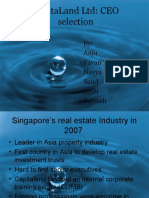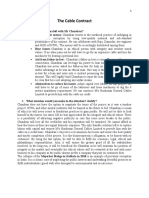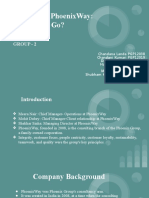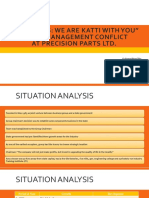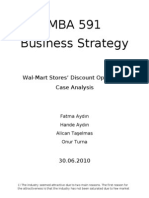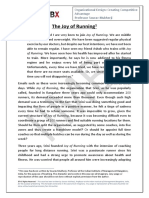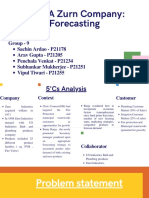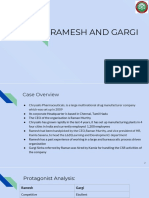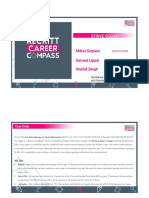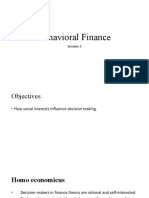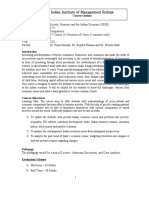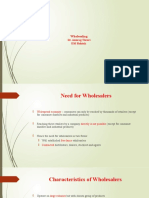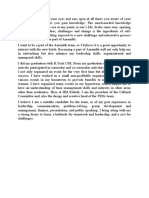This document is authorized for use only in IIM Rohtak's PG; BC course by Prof. Manas Tripathi & Prof. Abhishek Singh from Jul 1, 2021 to Dec 31, 2021.
FoodWorld (D): Design of MIS
1.Introduction
Mr. Ganesh Chella, VP (Retail) of RPG was thinking about the meeting which he just hadwith Mr. Mohapatra, President and Chief Executive, Retail Business Sector of RPG. It was January 1999. They were reviewing plans for the coming financial year, especially in terms ofbetter store level management. They had discussed the performance of the FoodWorld storesover the past year. The data on the sales and overall margin figures for the various storeshad given them an overall measure of performance, but it did not give them enoughinformation on the various underlying factors contributing to this performance. Mr. Chellawas concerned about how FoodWorld could devise a system that would provide them withquick access to information and aid in monitoring and control of store performance. FoodWorld was a division of Spencer’s, the retailing company under RPG enterprises. RPGwas one of the top business houses in India, with a sales turnover of Rs. 65 billion in 1996-97.RPG had entered into the retailing business with the acquisition of Spencer & Company in1989. They were the first serious players in India to get into organised retailing in a big way.
2.Understanding the Organisation
Based on a study of retail chains world over, it was felt that the retail format should be‘mass’ based rather than ‘niche’ based, since it offered greater growth potential. With thestrategic intent of entering the mass market, the Company entered the organised foodretailing industry under the brand name of FoodWorld. The first FoodWorld store was launched on May 9, 1996 in Chennai. New stores wereopened at regular intervals, until the current tally of 19 (six in Chennai, eight in Bangaloreand five in Hyderabad). The supermarket format was selected to offer the following:
•
Value based on price and quality,
•
Choice through self-service from a spread of merchandise and
•
A better shopping environment. The group had made an investment of Rs. 65 crore in the FoodWorld venture so far. Theturnover during 1996-97 was Rs. 21 crore, 1997-98 was Rs. 42 crore and was estimated to beRs. 87 crores in 1998-99. The gross margin on this turnover was 16.7% in 1996-97, 18.4% in1997-98 and was estimated to be 20.5% in 1998-99. All the stores had broken even, individually, within a few months of start and made acontribution towards regional and corporate expenses. The store operating expenses as apercentage of sales reduced over time as seen in Exhibit 1. This figure was higher during thefirst year, thus reflecting higher start-up costs. Within store operating expenses, salaries andwages accounted for about 2.5% of sales. In the future, salaries and wages, rent and
Indian Instue of Managemen Ahmedabad
IIMA/MAR0325(D)

This document is authorized for use only in IIM Rohtak's PG; BC course by Prof. Manas Tripathi & Prof. Abhishek Singh from Jul 1, 2021 to Dec 31, 2021.
2 of 13 IIMA/MAR0325(D) depreciation were expected to increase as newer and more expensive properties wereacquired. FoodWorld as a business enterprise was still in the red. This was typical of largeretail start-up businesses where a critical number of outlets were necessary before profitsshowed up. Infact, the business was still viewed as being in the ‘project phase,’ and expectedto breakeven only after 40 stores. The key focus at FoodWorld was to maximize traffic through the stores. Turnover of thestores could be increased by competitive pricing and promotions including discounts. Apartfrom increasing turnover in each of the stores by leveraging on the large store network, itwas imperative to increase margins to ensure sustainability and growth of the enterprise.Ensuring good margins required appropriate sourcing and negotiating with the suppliers forbetter margins. Lower costs required efficiencies in the regional distribution system thatFoodWorld had in place.
In this context, the merchandising function (what specific products/brands to offer andwhom to source from) and the distribution strategy (how to organise the logistics of supplyto the stores) gained significance as critical success factors. The vendor selection wascommon to all stores in a region and done by the regional office. Within the stores, inventorymanagement and display planning were critical to ensure availability and visibility.
3.Merchandising Function
A study of the customer preferences highlighted the following customer expectations interms of considering the store for food purchase: product range, variety for choice in a givenproduct, freshness, availability and reasonable price. In response to this, FoodWorld decidedto make available all items which a household shopped for on a daily, weekly or monthlybasis. The merchandising and display strategy was to be geared towards increasing the sizeof bill value (purchasing basket) for each customer. The merchandising offer was formed from staples, processed foods, beverages, non-food,health and beauty, perishables, and hardware and home appliances. These were divided into49 categories with the following category descriptor: destination, strategic (routine),convenience and speciality, depending upon essentiality of the product in the customers’purchase basket and the frequency of purchase. A category-wise description of items isgiven in Table 1. The categories were further subdivided into about 270 subcategories, toenable sourcing, keeping in mind the range of products available from suppliers. The totalnumber of stock keeping unit (SKUs) was more than 5000.
Table 1: Category Descriptors
Destination Strategic Convenience Speciality
Width
High High High High/ Med
Depth
High Low Low Low
Price
Aggressive, Key SKUs Aggressive, Value added for margins MRP MRP
Tactical usage
High Medium Medium Low
Examples
Cereals, Oil, Pulses, Flour Biscuits, Pickles, Baby food, Health and Beauty Noodles, Canned food, Cosmetics, Hardware and Home Appliances Pet food, Batteries, Paper goods
This document is authorized for use only in IIM Rohtak's PG; BC course by Prof. Manas Tripathi & Prof. Abhishek Singh from Jul 1, 2021 to Dec 31, 2021.
3 of 13 IIMA/MAR0325(D)
Source: FoodWorld-B
For each of the sub-categories, average margin and turnover figures were analysed. Most ofthe sales came from branded non-perishables. Revenue share and margin spreads of themain items are given in Table 2. The top 1000 SKUs accounted for 70% of the revenues.However, the perishables and non-branded repacked SKUs (about 100) were expected towitness the highest growth with higher than average margins.
Table 2: Revenue Share and Margin Spread Item Revenue % Margin spread%
Perishables 15 Branded Frozen 10-20 Dairy 4-10 Unbranded Bakery 30 Fruits and vegetables 25 Repacked items (company branding) 10 5-20
All others
75 15
Source: FoodWorld-B
4.Layout and Operations
The stores followed a policy in which destination category components of a purchase basketwere typically in the far end of the store to attract customers’ right into the store. A bay withsix shelves had around 18 running feet and could accommodate 45-70 facings of SKUs,depending on SKU dimensions. An SKU may have one to three facings based upon the salesvolume and desired visibility. The typical number of bays and SKUs based on the type of thestore are given in Table 3. Each store, depending on its specific floor plan, had a ‘planogram,’which specified in detail the category-wise layout across the various shelves and bays. The‘planogram’ was developed based on an analysis of the local requirements and was expectedto be followed religiously. An important decision was: which SKUs to display in which bay, by understanding thecustomer search process in seeking out SKUs Even though a fixed location for an SKUfacilitated the repeat customers to quickly access their requirements, clever clustering ofSKUs depending on promotions, and the customers’ basket of purchases helped inincreasing sales of some SKUs.
Table 3: Store Details by Type
Storetype Trading area (Sq ft) No. of stores Example location Typical no. of bays No. of SKUs
A
6000+ 2 MG Road (Bangalore) Mount Road (Chennai) 120+ 6000
B
3000+ 9 Himayatnagar (Hyderabad) 80-95 4500
This document is authorized for use only in IIM Rohtak's PG; BC course by Prof. Manas Tripathi & Prof. Abhishek Singh from Jul 1, 2021 to Dec 31, 2021.
4 of 13 IIMA/MAR0325(D)
Gandhi Nagar (Chennai)
C
2000+ 8 Jaynagar (Bangalore) Marredpally (Hyderabad) 65-75 3000
Source: Food World-B
The number of checkout counters (tills), staff assignments, assignment of tills for differenttypes of customers (large/small volume, cash/credit), were also decisions of significance. Another area of concern for store operations was ‘shrinkage,’ i.e. the losses due to theft. This figure could be as high as 1
.5% of sales and was a continuous challenge to the management, who were targeting a figure of no more than 0.5%.
5.Supply Chain Strategy
Among all the challenges, Mr. Chella felt that the one relating to managing the supply chainwas going to be critical. The key elements of FoodWorld’s distribution strategy were:
Creation of a Regional Hub
: Three regional hubs at Chennai, Bangalore and Hyderabadcatered to state-wise requirements. 90% of the items were supplied through thesewarehouses and the remaining directly to the stores.
Replenishment Frequency
: The ideal servicing expected by the stores from the warehouseswas daily, while the supply frequency was twice a week. (Hardware and generalmerchandising items were treated as exceptions. No stocks were kept in the warehouse.They were to be indented and ordered as required.) The request for stocks made by the different stores on the warehouse or the direct supplyservicing them was called the indent. Most SKUs could be indented twice a week onnominated days, for which supply was made from the warehouse after a gap of one day. Thenomination of days was to achieve synchronisation at the warehouse level. Exhibit 2 shows awarehouse pick list based on an indent from a store. Each SKU in a store had two specific attributes that helped indenting, namely minimum basequantity (MBQ) and supply unit factor (SUF). The MBQ was determined as follows: MBQ = (120% of highest sales achieved per month)/4 The rationale behind this was to ensure enough stocks even if there was a surge in demandand no supply from the warehouse for one indent. The indent quantity was determined aftera physical verification of store stocks on nominated indent days, as follows: Indent quantity = (MBQ – Physical Stock) in multiples of SUF The SUF took into account the smallest number of units of an SKU that could beconveniently supplied to a store by the warehouse, typically based on the pack sizes comingin from the supplier. The average stock turns per year were 12 in 1997 and expected to be higher in 1998. For mostSKUs, the shelf space volume was kept less than the MBQ in order to enable frequentreplenishment and to provide a sense of fullness of the shelves.














